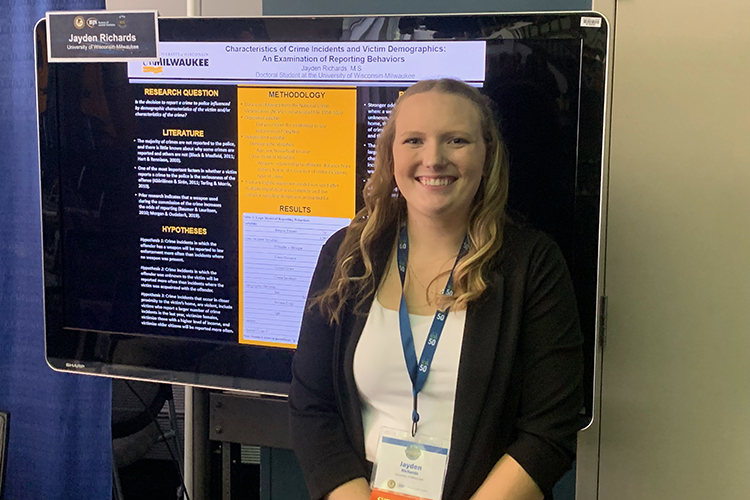An estimated 40% to 50% of victims don’t report crimes to police.
Jayden Richards was interested in the “why” behind that statistic. She is a doctoral student in social welfare with a focus on criminology in the Helen Bader School of Social Welfare.
Because of her research on the topic, Richards was one of five students nationally who were invited to the Department of Justice’s 50th anniversary celebration of the National Crime Victimization Survey in Washington, D.C., during the fall semester.
The goal of the conference was to highlight how the survey data could be used, Richards said.
The National Crime Victimization information comes through the U.S. Census rather than police reports. “This is about the only way to look at crimes that aren’t reported to police,” Richards said.
Presence of a weapon proves significant
In her research, using data from 1994-2020, Richards studied factors such as the victim’s gender; whether a weapon was used; whether the victim had previously been a crime victim; whether the crime involved property or included violence; how close to the victim’s home the incident occurred; and whether the victim knew the criminal.
“The presence of a weapon was the most significant finding,” Richards said. “The odds of reporting a crime were over two times larger when the offender had a weapon.”
Another key finding was that victims were more likely to report the crime if they didn’t know the perpetrator. “The odds were 1.6 times greater that they would report the crime if they did not know the criminal. So, essentially, they were less likely to report the crime if they knew the person,” she said. “That was consistent with prior literature and what we would expect.”
Factors involved
While those two factors had the strongest significance, Richards also found that females were more likely to report crimes. When the crime occurred closer to home, victims were also more likely to report it. In addition, violent crimes were more reported than property crimes. Those who had been crime victims fewer times previously were also more likely to report a crime.
“You would think that if someone had a large number of crimes committed against them, at some point they would be more likely to report the crimes but that was, in fact, not true.” It’s possible, she said, that the population that generally has more crimes committed against them is also more distrustful of police. “That could be a discussion for future research,” she said.
The psychology of criminal behavior
Richards, who is from Wausau, earned her bachelor’s in psychology from UW-Madison in 2019, then completed her master’s in criminology and crime analytics from UWM in 2022. She started the doctoral program right after she completed the master’s degree.
“I’m interested in the psychology behind criminal behavior and that’s what really drove me to look at criminology as a field. It’s so interesting and much more about statistics than the crime shows make it out to be.”
She came to UWM because of her interest in statistics and research. “I really liked the fact that UWM is a Research 1 institution, and they just have so many opportunities for students.” The fact that the university offered the criminology program also impacted her decision, she added.
Richards is starting work on her dissertation, which will focus on rape myths and how they affect both victims and perpetrators, but she is hopeful she can eventually continue the crime victim research.
“The great thing about me being able to present this research at the conference was that I got to share my findings and where I thought research could be headed. I was able to offer suggestions to a lot of very consequential people within the criminal justice system. That was extremely neat.”







